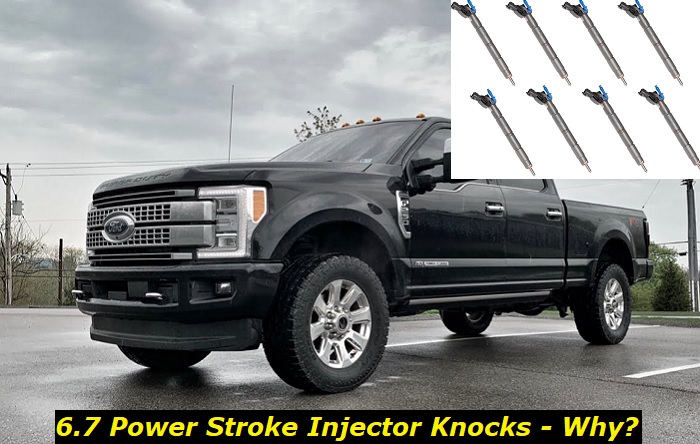Ford Motor introduced the 6.7L as its first in-house Power Stroke engine. Ford designed it as a medium-duty diesel engine.
Key features and my opinion about the engine
- Production years:2011-2016
- Average lifespan of 6.7 Power Stroke:240,000-270,000 miles
- Fuel supply type:Common Rail
- Power range:330-475 hp
- Fuel efficiency:average
- Engine block material:cast-iron
- Engine reliability score:medium
- The most common problems:turbo problems, cooling system issues, weak sensors, CP4 pump problems.

An Overview of the 6.7 Power Stroke Engine
The engine is a 6700 cc v8 four-Stroke turbocharged diesel engine. Ford Motors released the first 6.7 Power Stroke series in 2011. It replaced the 6.4L Power Stroke, becoming the first in-house Power Stroke series.
Ford Motor uses graphite to make the motor's cylinder block. It also has a cast-aluminum cylinder head with a reverse flow design. Most diesel engines come with a cross-flow head. Such powerhouses have inlets and exhaust ports on opposite sides of the block. The location of the inlet and exhaust ports lets the gases travel from the inlet port across to the outlet.
The reverse-flow design is the opposite of this. The inlet and the exhaust ports are on the same side. Therefore, the gas will move from the inlet port and flow back to the exhaust port. Hence, the reverse flow tag. The design makes the engine more efficient.
The efficiency translates to 400- 475 hp at 2,600 to 2800 revolutions per minute and a torque of 800-1050 lbs at 1600 revolutions per minute. The connecting rods are capable of withstanding the high horsepower and torque because of its made out of forged steel. You'll notice that the engine's connecting rods are almost similar to those on the Cummin diesel engine.
6.7 Power Stroke Injector System
The motor doesn't use a lift pump to draw fuel from the tank. It uses a fuel conditioning module. It uses an electronically controlled pump to pull fuel from the tank.
Its fuel system features a high-pressure direct injection system (common rail direct injection system). It's a CP4.2 high-pressure injection system. The fuel injection process is efficient and slightly quiet.
The newer generation 2015+ 6.7 Power Stroke motors have injection pumps that allow more fuel flow. Ford also improved its injector. The nozzle tips can deliver finer fuel spray. The improved injection pump and injector make the 2015+ models have better torque and horsepower.
6.7 Power Stroke Injector Knock
Your diesel engine cannot operate without an injector. Any damage to the injector may cause it to vibrate inside your engine. The vibrations may manifest as injector knocks. Despite the improvements, the diesel engine may develop injector noise. You'll hear a type-writter-like noise if you listen keenly. It often comes up during idle or when starting the engine.
The knocks are common among diesel engines because the fuel works under high pressure. The small components like the valves, pipes, and metal caps may create a knocking noise due to the pressure as they work to deliver fuel to the combustion chamber. Additionally, the oil that flows through the engine is not filtered. Therefore, it may produce loud noises during ignition.
The knocks are more frequent and lighter than engine knocks.
Causes and How To Silence the Injector
Internal engine sounds and noises are often hard to diagnose. You may hear knocks, bangs, clings, or clangs as you drive your truck. Injector knocks are the primary sign of a failing fuel injector system. The knocks may occur if the injector fails to spray or atomize the fuel as expected. The knocks may become apparent when the car is idle or hauling a mild load.
Here are some of the causes and possible fixes.
- Raised Compression
Diesel engines have a higher compression ratio than gasoline engines compression ratio. Instead of fuel mixing with air before heading to the combustion chamber, the pistons move the air to the combustion chamber. The chamber compresses the air turning it into smaller molecules. The injector will then spray the fuel into the compressed air. The heat coming from the compressed air will ignite the mixture. The compression and ignition of the blend may manifest as injector knocks. Such knocks are not a concern as they are part of the combustion process.
However, your motor may develop low compression. Low compression is not usual among diesel engines. However, it causes frequent and loud injector knocks when it occurs. The low compression ratio doesn't sync well with the fuel injection process. It will lead to incomplete combustion of the air-fuel blend causing spontaneous sparks that may burn uncontrollably. The uncontrollable burns may produce intense pressure waves that sound like typewriter-like knocks.
Fix:
A cracked cylinder wall may trigger low compression ratio issues. Crank your engine and open the radiator. Check whether you can see air bubbles. There is a leak in the cooling system if you see bubbles. The bubbles are due to a cracked wall on the cylinder wall. Check whether the gasket is misaligned or worn out. You can also use a pressure gauge or tester to check if there are issues with your gasket. You could also have leaks on the piston rings, valves, camshaft, valves, or the piston.
Seal or replace the leaking parts to raise the compression ratio.
- Unlubricated Injector
The injector knocks could also be due to insufficient lubrication of the injector. Over time the injector may become unlubricated due to fuel contamination or moisture-packed fuel.
Using the recommended fuel will solve the problem because it will lubricate the entire injector system.
- Self-Ignition of Unburned Fuel-Air Mixture
The knock could be a result of the self-ignition of the unburned mixture. The self-ignition is a by-product of incorrect fuel mixture and residue from previous combustion cycles. When air and fuel do not blend well, it often results in an insufficient combustion process. The incomplete combustion will leave hot residues in the combustion chamber or the cylinder wall. The unburned residue may self-ignite due to the compression, high pressure, and high temperature, causing knocks in the engine. The self-ignition may also occur during the pre-mixture stage when the injected fuel auto-ignites. The auto-ignition may lead to an ignition relay resulting in excessive injector noise.
Fix:
The self-ignition often occurs if your fuel is contaminated, you have a faulty injection system, or you've used a low-quality fuel substitute. Therefore, your solution lies in managing the contamination or the substandard fuel. Consider cleaning the fuel tank and fuel filters. Also, get a new fuel filter if you've driven 50,000 miles without changing them.
- Build-Up in the Fuel Injector
Deposits at the tip of the nozzle (injector tips) may build up as fuel passes through the fuel injector. The build-up may also occur inside the injector due to hydrocarbons and fuel residue. The injector absorbs heat from the engine, causing the remaining fuel in the ejector to evaporate. Therefore, leaving hard residue in the injector.
The deposits may disrupt the fuel spray function, causing reduced efficiency. You may hear injector knocks as it sprays the fuel because of the deposit build-up. Over time the hard residue will block the injector.
Fix:
You'll need to clean the fuel injector to let it properly pray and automize fuel. You will need to clean the injector once a year. The cleaning kit is easy to use and leaves you with a clean fuel injector. Disconnect the injector from the fuel pump, the vacuum line, and connect the cleaning kit. Untighten the cap from the tank to prevent pressure build-up. Start your engine and let the cleaner run.
- Fuel Leaks
Leaks in the injector occur due to o-ring failure. The o-ring seals fuel and fuel vapor from getting into the engine. As the injector soaks the engine heat, it causes the o-ring to become brittle. The cracks may develop on the o-ring, causing fuel leaks in the injector.
The leaks may affect how the injector sprays and atomizes the fuel. Anything that reduces the injector's spray and atomizing ability may cause injector knocks.
Fix:
You'll need to replace the o-rings to prevent the fuel and fuel vapor leaks. Also, consider cleaning the injector before changing any part of the injector. Raise the hood and check if there is a leak. Turn off the truck if you notice a fuel leak. Detach the pump, cover the leaking part with a towel, and start your engine. Let it run until you hear a stall. Remove the rail once you notice lower fuel pressure.
Remove the O-rings seals and put in new ones.
Summary
Your 6.7 Power Stroke powerhouse will need a working injector to operate. Therefore, you shouldn't ignore any odd noises coming from the injector. The noises may indicate a defect within the fuel injector system.
Injector knocks, for instance, show that the fuel injector cannot deliver the fuel to the combustion chamber as it should. The failure could be due to leaks, carbon build-up, or low compression. If ignored, the knocks could cause irreversible damage to the engine.
About the authors
The CarAraC research team is composed of seasoned auto mechanics and automotive industry professionals, including individuals with advanced degrees and certifications in their field. Our team members boast prestigious credentials, reflecting their extensive knowledge and skills. These qualifications include: IMI: Institute of the Motor Industry, ASE-Certified Master Automobile Technicians; Coventry University, Graduate of MA in Automotive Journalism; Politecnico di Torino, Italy, MS Automotive Engineering; Ss. Cyril and Methodius University in Skopje, Mechanical University in Skopje; TOC Automotive College; DHA Suffa University, Department of Mechanical Engineering






Add comment